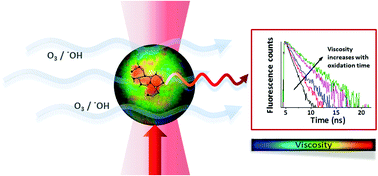Dynamic viscosity mapping of the oxidation of squalene aerosol particles†
Abstract
Organic aerosols (OAs) play important roles in multiple atmospheric processes, including climate change, and can impact human health. The physico-chemical properties of OAs are important for all these processes and can evolve through reactions with various atmospheric components, including oxidants. The dynamic nature of these reactions makes it challenging to obtain a true representation of their composition and surface chemistry. Here we investigate the microscopic viscosity of the model OA composed of squalene, undergoing chemical aging. We employ Fluorescent Lifetime Imaging Microscopy (FLIM) in conjunction with viscosity sensitive probes termed molecular rotors, in order to image the changes in microviscosity in real time during oxidation with ozone and hydroxyl radicals, which are two key oxidising species in the troposphere. We also recorded the Raman spectra of the levitated particles to follow the reactivity during particle ozonolysis. The levitation of droplets was achieved via optical trapping that enabled simultaneous levitation and measurement via FLIM or Raman spectroscopy and allowed the true aerosol phase to be probed. Our data revealed a very significant increase in viscosity of the levitated squalene droplets upon ozonolysis, following their transformation from the liquid to solid phase that was not observable when the oxidation was carried out on coverslip mounted droplets. FLIM imaging with sub-micron spatial resolution also revealed spatial heterogeneity in the viscosity distribution of oxidised droplets. Overall, a combination of molecular rotors, FLIM and optical trapping is able to provide powerful insights into OA chemistry and the microscopic structure that enables the dynamic monitoring of microscopic viscosity in aerosol particles in their true phase.



 Please wait while we load your content...
Please wait while we load your content...